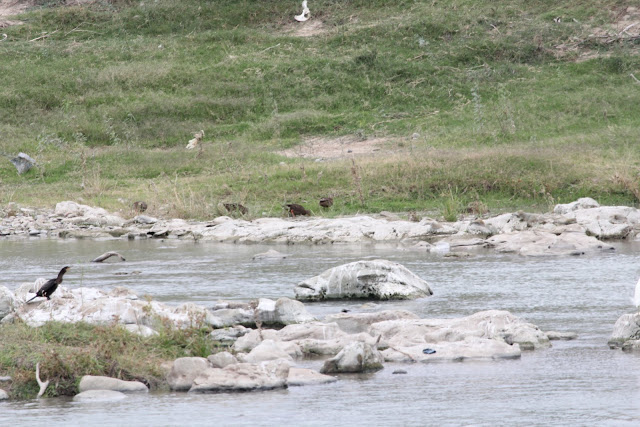
At some point in the past few months, I decided that as my trip to North Carolina was rudely canceled by that $#*&% Irene, I deserved a replacement treat. I decided to re-visit the birding festival that got my life list past 400 back in 1998; the Rio Grande Valley Birding Festival. So, new camera and steadfast old binocs in hand, I flew down to Harlingen, Texas, the heart of tropical birding in the U.S. A.
I enjoyed the sojourn to La Laja Ranch, a private ranch that allowed the festival to drag us birder types on in search of the now scarce White-collared Seedeater. The La Laja Ranch added 2 new birds to my life list; this pretty little male Seedeater and a Clay-colored Thrush. I was amazed I managed to get half decent shot of the tiny seedeater. The thrush was not so accommodating. The little south Texas 'speciality', the White-collared Seedeaters prefer to inhabit stands of canes that grown along the shores of the Rio Grande River.

The tour spotted more than 100 species on the Seedeater tour. Below is a horrible photo I took, and love. I took it facing Mexico, on the other side of the Rio Grande River. Why do I love it? First, because it's taken from the spot where I saw the Seedeater, but on the lower left, there is a sunning Neotropical Cormorant and the three brown spotches on the Mexican bank are a species I don't see more than once a decade; Mottled Ducks. There had been Egrets, Spotted Sandpiper and even a Greater Roadrunner in the scene before I aimed my camera, but they proved camera shy.

and Mottled Ducks all for yourself
Birds don't just pop out of the shrubbery because one shows up, so I had time to experiment while we all waited patiently for White-collared Seedeaters to appear. Because my camera already weights a ton, I didn't bring my spotting scope to Texas. But happily, others did. I took the photo below using my iPhone. It was tough, but not impossible for me to align the lens so I could snap a shot of a Long-billed Thrasher, through a spotting scope. The bullet hole look is called 'vignetting' in digiscoping lingo.

with iPhone, through spotting scope
As soon as I had the shot, I stretched the photo in my iPhone and took a screen shot of it. Here below is the result - much finer than I expected.

Getting the initial shot is tricky and rather a painstaking pain-in-the-butt, but if one is in a pinch, the end result certainly would beat not having a photo at all. Decided to continue the experiment when the opportunity arises. I can't wait to take my time and try iPhone digiscoping with my own spotting scope when I get home.
There were many small birds along the river, and I saw Blue-headed and White-eyed Vireo, Northern Cardinals, Blue-gray Gnatcatchers, Ladder-backed & Golden-fronted Woodpeckers, and Olive Sparrows.

On Thursday morning I was up for my trip to the famous GIGANTIC King Ranch, the Norias Unit. The King Ranch is larger than Rhode Island and is famous for it's Santa Gertrudas cattle, an amazing history, hunting, wildlife & the management thereof.
The birding tour I was on had it's sites set on finding a Ferrugineous Pygmy Owl. When I visited the Ranch in 1998 I saw at least a half dozen of the amazing bitty owls. Alas, this trip the owls called, but stubbornly remained hidden to most of the tour, including myself. Happily, Harris's Hawks, White-tailed Hawks, Northern Beardless Tyrannosaurus (a tiny adorable flycatcher), Audubon's Orioles, Greater Kiskadees, and many other Texas birds were readily visible, and many of them are south Texas specialities.


south Texas in the ABA checklist area,
There were plenty of mammals to enjoy as well. I was tickled to also see, in broad daylight, buck White-tailed deer, Rio Grande wild Turkeys by the hundreds, two mischievous raccoons and this Javalina below - that's a pig-thingie formerly known as Collared Peccary.

time to watch the weird humans nearby
The King Ranch is has it's share of exotic species, that thrive - perhaps better than one would hope - on the scrub, shrub and thorns on the Ranch. Here is a massive Nilgai doe - native to India - heading into the outback.

I got no new birds on the King Ranch, but saw at least 50 that were fun to see, many for the first time since my last visit in 1998. Post-Ranch tour, I drove on down to Brownsville, where I put in a visit to Audubon's Sabal Palm Sanctuary.

I could barely tear myself away from the feeders next to the office. Plain Chachalacas bounced about and raided the feeders and those gems of the Jay family, Green Jays, kept an eye on everything and raided a feeder or two themselves.


I recall the last time I visited the Sanctuary, a Barred Owl hooted the entirety of my visit. This time the place was quiet and I took the short hike over to blinds from which I could watch and photograph loads of wild Redhead ducks and loads of the utterly adorable ensie Least Grebes. The grebes were the size of ducklings and thoroughly charming.

I arrived so late to the Sanctuary, I had less than an hour to explore it. My last ten minutes were spent by a butterfly garden behind the visitor center. As I waited by a hummingbird feeder, a beautiful male Buff-bellied Hummingbird zipped up to the feeder, darted about like a fairy on methamphetamine and buzzed off. Hurrah! I was rewarded with a lifer bird, one that miraculously evaded me in 1998, because a cold winter had nearly wiped the birds out.
I was bummed I didn't get a photo of my lifer Buff-belly Hummer, but then again, LIFER number five hundred ninty-nine! One more to go.
